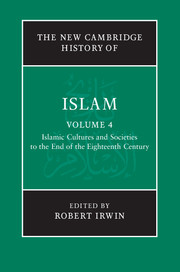Book contents
- Frontmatter
- Introduction
- PART I RELIGION AND LAW
- PART II SOCIETIES, POLITICS AND ECONOMICS
- PART III LITERATURE
- 13 Arabic literature
- 14 Persian literature
- 15 Turkish literature
- 16 Urdu literature
- 17 History writing
- 18 Biographical literature
- 19 Muslim accounts of the dār al-ḥarb
- PART IV LEARNING, ARTS AND CULTURE
- Glossary
- Bibliography
- Index
- References
13 - Arabic literature
from PART III - LITERATURE
Published online by Cambridge University Press: 28 March 2011
- Frontmatter
- Introduction
- PART I RELIGION AND LAW
- PART II SOCIETIES, POLITICS AND ECONOMICS
- PART III LITERATURE
- 13 Arabic literature
- 14 Persian literature
- 15 Turkish literature
- 16 Urdu literature
- 17 History writing
- 18 Biographical literature
- 19 Muslim accounts of the dār al-ḥarb
- PART IV LEARNING, ARTS AND CULTURE
- Glossary
- Bibliography
- Index
- References
Summary
Formative cultures and identities
The pre-Islamic poet
Ask if you are uninformed about my people when the horses return from the inflicting of wounds!
We halt in the [most] fearsome spot of every protected grazing-ground and mountain pass and no territory close to us can be ravaged,
On prancing mares and noble stallions, lean-bellied, strongly-built, with prominent withers, brisk and energetic.
When we halt in the very heart of a tribe’s territory it receives no respite from fierce, constant warfare.
When war girds herself, we arise like full-grown camels in the wide enclosure
On lean-flanked, tight-bellied [horses] that kick up dust on the tousled [braves], fair of face.
This is how Bishr ibn Abῑ Khāzim, who lived towards the end of the sixth century CE, describes his tribe and, by extension, himself. Arabic poetry as the vehicle of heroic themes, one of its primary roles through all succeeding periods, was the invention of pre-Islamic poets such as Bishr. It expressed the ideals of tribal society to tribal audiences, but may also have reflected wider political ambitions, boasting to the Byzantines and Sasanians of the fighting qualities of the Arabs who skirmished with each other on their borders. Verse as early as that of Bishr is already both highly wrought and freighted with ethical symbolism, and its conventional motifs are more than merely descriptive.
- Type
- Chapter
- Information
- The New Cambridge History of Islam , pp. 381 - 413Publisher: Cambridge University PressPrint publication year: 2010
References
- 2
- Cited by



